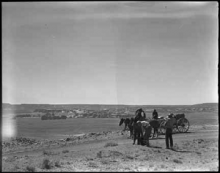Article
A two-track path created by four-wheeled wagons drawn by draft animals such as oxen or horses. The wheels created two ruts, marking routes that other travelers could follow and that left traces over the landscape that could be read for centuries. Travelers in wagons would often follow routes already created by indigenous peoples, appropriating traditional travel ways that had been previously used for trade and pilgrimage.
"Horses and wagon on the road to Acoma Pueblo, New Mexico," photograph, T. Harmon Parkhurst Collection (001932). Palace of the Governors Photo Archive, New Mexico History Museum. All rights reserved. Use with permission only.
Manuscripts
A01 The Blessing Way (01-07) p. 78
A01 The Blessing Way (01-07) p. 80
A01 The Blessing Way (01-07) p. 180
References
Lyman, Edward
2004 The Overland Journey from Utah to California: Wagon Travel from the City of Saints
to the City of Angels. Reno: University of Nevada Press.
Shumway, George
1964 Conestoga Wagon, 1750-1850: Freight Carrier for 100 Years of America's Westward
Expansion. Williamsburg: Early American Industries Association.
Waldman, Carl
2009 Wagon Roads, Railroads, and Canals. Atlas of the North American Indian, Third
Edition. New York: Facts On File, Inc.

